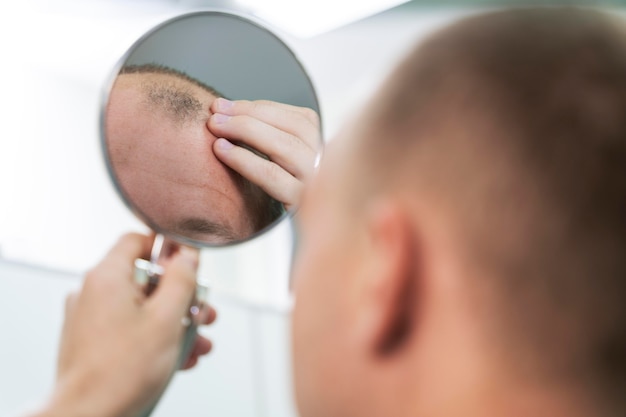Scalp micropigmentation (SMP) is a cosmetic procedure that is gaining popularity as a non-invasive and long-lasting solution for hair loss. The process involves injecting pigments into the scalp to stimulate hair follicles, which produces immediate and natural-looking results that can endure for several years with the right maintenance.
It’s worth noting that pigment shedding is a normal part of the healing process following an SMP treatment, and patients may notice small flakes of pigment falling off their scalps. Nonetheless, these pigments settle into the scalp over time, creating a more natural appearance that adds to an individual’s self-esteem.
However, with its increasing popularity, a number of misconceptions about scalp micropigmentation have also emerged. In this blog, we will address 5 common misconceptions about scalp micropigmentation and its effects on those seeking this treatment.
Table of Contents
Misconception #1: SMP is Only for Bald People
Scalp micropigmentation is a versatile and effective solution for hair loss issues that can be customized to meet the needs of a wide range of patients. One of the most pervasive misconceptions about this treatment is that it is only appropriate for individuals who are completely bald. However, SMP is a practical option for many different types of hair loss, including receding hairlines, thinning hair, and even scars on the scalp.
Misconception #2: SMP is Painful
One of the most prevalent misconceptions about scalp micropigmentation is that the procedure is excessively painful. However, this is not entirely true. While some level of discomfort can be expected, it is usually mild to moderate rather than severe pain. Additionally, experienced SMP technicians use numbing agents to help manage any discomfort during the procedure. These agents can be applied topically to the scalp before the treatment, making the procedure much more comfortable for the patient. Therefore, those who are considering scalp micropigmentation should not let the fear of pain deter them from pursuing this highly effective hair restoration option. Instead, they should consult with an experienced SMP technician to learn more about the treatment process and what to expect.
Misconception #3: SMP is a Tattoo
There is a common misconception that scalp micropigmentation is just a type of tattoo. However, while both procedures involve injecting pigment into the skin, there are significant differences between the two. Scalp micropigmentation uses specialized pigments that are specifically formulated for the scalp, unlike traditional tattoos. These pigments are designed to create a natural and realistic look that mimics the appearance of real hair follicles. Additionally, SMP is applied to the scalp in a highly controlled and precise manner, which ensures that the pigments are distributed evenly and accurately. As a result, the final results of SMP treatment can be highly convincing and difficult to distinguish from natural hair.
Misconception #4: SMP Requires no Maintenance
Many people believe that scalp micropigmentation is a one-time treatment that requires no further maintenance. However, this is not the case. While SMP is a long-lasting solution for hair loss, it is not a permanent one. Over time, some fading and pigment shedding can occur, which may require touch-up sessions to maintain the best possible results. Additionally, pigment shedding is a normal part of the healing process, and should not be a cause for concern. To keep your scalp micropigmentation looking its best, it is important to follow up with your technician as recommended to schedule touch-up sessions every few years. By doing so, you can enjoy the full benefits of SMP for many years to come.
Misconception #5: SMP Looks Fake

Scalp micropigmentation is often wrongly associated with creating an artificial or “fake” look. This is completely untrue. The procedure is designed to mimic the appearance of natural hair follicles, resulting in a highly realistic and natural-looking outcome. SMP technicians use specialized pigments that match the patient’s natural hair color and texture to create the illusion of real hair growth. They carefully consider the patient’s natural hairline, style, and density to ensure a seamless transition from real hair to pigmented areas. Furthermore, the application process is precise and controlled, resulting in a consistent and uniform appearance that looks as if the hair is growing naturally. With the right SMP technician and proper aftercare, the results can be incredibly convincing and indistinguishable from natural hair.
Conclusion
Scalp micropigmentation is a safe, non-invasive, and long-lasting treatment for hair loss that can have a significant positive impact on an individual’s self-confidence and quality of life. While there are common misconceptions associated with this treatment, being informed and seeking out an experienced SMP technician can help alleviate concerns and ensure the best possible outcome. With its ability to deliver immediate and natural-looking results, scalp micropigmentation is an attractive option for those who are experiencing hair loss and want to restore the look of their hair.



